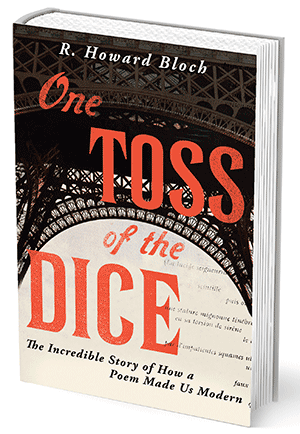Nonfiction Review
One Toss of the Dice: The Incredible Story of How a Poem Made us Modern, by R. Howard Bloch ’65 (Liveright)
Perhaps you’re unfamiliar with Stéphane Mallarmé, French poet of the Belle Époque, and his seminal experimental poem “One Toss of the Dice Will Never Abolish Chance” but, in the introduction to his masterful examination of the subject, R. Howard Bloch ’65 makes sure you’re familiar with the artistic tradition Mallarmé helped foster.“The logical leaps of ‘One Toss of the Dice,’” Bloch writes, “Were the first signs of what would become the free-associative modernist novel—Marcel Proust’s flashbacks of involuntary memory, Franz Kafka’s wild mixings of fantasy and everyday life, James Joyce’s and Virginia Woolf’s streams of consciousness, and Gertrude Stein’s ‘continual present.’”
Mallarmé’s 20-page masterwork—an epic-in-brief that could be described as a kind of explication of temporality and simultaneity—overturned almost every established poetical precept. It was Mallarmé’s attempt to free the form from, as Bloch writes, “the rhythm base of poetry—its relation to music, measure, beat and time.”
Before presenting the poem in French and English, Bloch provides a lively biography of Mallarmé, an established poet who nevertheless always required a day job. He hosted salons frequented by William Butler Yeats and Claude Monet. (Oscar Wilde appears briefly, but is shunned for speaking too much about himself.)

The poem itself refuses to be excerpted. Font sizes change seemingly at random, words cascade down the page, and in some places it’s unclear whether the reader’s eye is meant to move downward as usual, or across the “gutter” of the folio, from the verso to the recto. Much importance is placed on blank space—some pages contain only a line or two.
Artistic ideas merge with the media employed to represent them, so that a line about “the Abyss … roiling beneath a desperately sloping incline” is fractured and rendered declining down the page. This poem about the passage of time also attempts to subvert or arrest it. As Bloch writes, Mallarmé “created a great simultaneous sentence that renders both the objective uniform passage of clock time and the vast stillness of eternity.”
It’s sentences like the above that make Bloch’s effort such a pleasure. The reason this single poem can maintain a book-length investigation is that, as Bloch shows, its opacity is a feature rather than a bug, an inviting challenge that rewards close analysis. Bloch’s book, although far less opaque than the poem that inspired it, is equally rewarding.
Nicholas Mancusi ’10 is a New York-based writer and critic.
